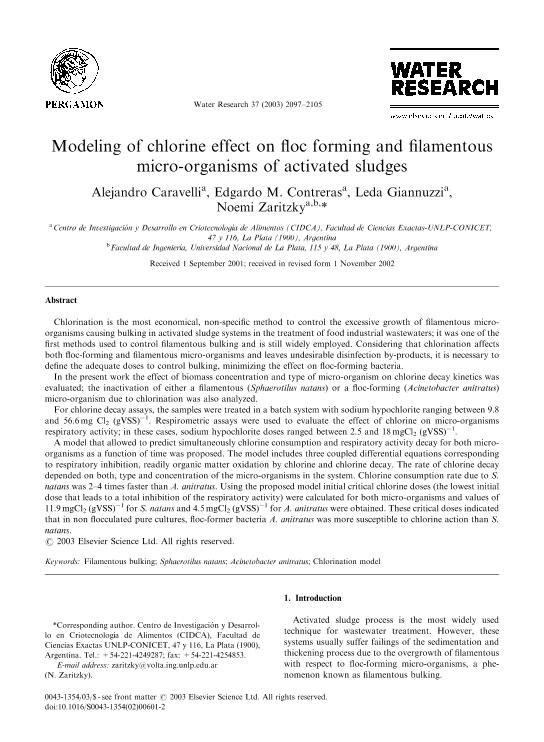Mostrar el registro sencillo del ítem
dc.contributor.author
Caravelli, Alejandro Horacio

dc.contributor.author
Contreras, Edgardo Martin

dc.contributor.author
Giannuzzi, Leda

dc.contributor.author
Zaritzky, Noemi Elisabet

dc.date.available
2021-03-02T14:49:09Z
dc.date.issued
2003-03
dc.identifier.citation
Caravelli, Alejandro Horacio; Contreras, Edgardo Martin; Giannuzzi, Leda; Zaritzky, Noemi Elisabet; Modelling of chlorine effect on floc forming and filamentous micro-organisms of activated sludges; Pergamon-Elsevier Science Ltd; Water Research; 37; 3-2003; 2097-2105
dc.identifier.issn
0043-1354
dc.identifier.uri
http://hdl.handle.net/11336/127137
dc.description.abstract
Activated sludge technology is more used than any other for biological treatment of wastewater. However, filamentous bulking is a very common problem in activatedslud ge plants, chlorine being the chemical agent normally used to control it. In this work the effect of chlorine on microorganisms present in activatedslud ge flocs was assessed by a respirometric technique (oxygen uptake rate, OUR) and by the INT-dehydrogenase activity test (DHA) measured by two techniques: spectrophotometry (DHAa) andimage analysis (DHAi). Both DHA tests were optimized and correlated with the respirometric technique (OUR) using pure cultures of a filamentous microorganism (Sphaerotilus natans) under chlorine inhibition. Using these correlations the tested methods were applied to determine the action of chlorine on respiratory activity in activatedslud ge. The OUR andthe DHAa quantifies the action of chlorine on the total respiratory activity (RA) of flocs (filamentous andfloc-forming bacteria); in contrast, the DHAi test evaluatesspecific action of chlorine on the RA of filamentous microorganisms.In activated sludge flocs containing filamentous microorganisms, a chlorine dose of 4.75mg Cl2 (gVSS)1 with a contact time of 20 min reduced about 80% of the RA of filamentous bacteria while affecting only 50-60% of the total RA of flocs. Besides, a chlorine dose of 7.9 mgCl2 (gVSS)1 produced the total respiratory inactivation of filamentous microorganisms after 10 min contact, however, with this dose the total RA of activated sludge flocs was reduced only about 45–65%; controlling filamentous bulking without affecting too much floc-forming bacteria.At the testedchlorine concentrations the inhibition of filamentous microorganisms was higher than in the whole activated sludge. Although floc-forming microorganisms were demonstrated to be more susceptible to chlorine than filamentous in pure cultures, results obtainedin the present work confirmed that it is the location of the filamentous microorganisms in the flocs and the presence of extracellular polymer substances which largely determines their higher susceptibility to chlorine; consequently this feature plays a critical role in bulking control.
dc.format
application/pdf
dc.language.iso
eng
dc.publisher
Pergamon-Elsevier Science Ltd

dc.rights
info:eu-repo/semantics/openAccess
dc.rights.uri
https://creativecommons.org/licenses/by-nc-sa/2.5/ar/
dc.subject
S.natans
dc.subject
filamentous microorganisms
dc.subject.classification
Otras Ingeniería del Medio Ambiente

dc.subject.classification
Ingeniería del Medio Ambiente

dc.subject.classification
INGENIERÍAS Y TECNOLOGÍAS

dc.title
Modelling of chlorine effect on floc forming and filamentous micro-organisms of activated sludges
dc.type
info:eu-repo/semantics/article
dc.type
info:ar-repo/semantics/artículo
dc.type
info:eu-repo/semantics/publishedVersion
dc.date.updated
2021-02-17T20:10:50Z
dc.journal.volume
37
dc.journal.pagination
2097-2105
dc.journal.pais
Estados Unidos

dc.journal.ciudad
Amsterdam
dc.description.fil
Fil: Caravelli, Alejandro Horacio. Provincia de Buenos Aires. Gobernación. Comisión de Investigaciones Científicas. Centro de Investigación y Desarrollo en Criotecnología de Alimentos. Consejo Nacional de Investigaciones Científicas y Técnicas. Centro Científico Tecnológico Conicet - La Plata. Centro de Investigación y Desarrollo en Criotecnología de Alimentos. Universidad Nacional de La Plata. Facultad de Ciencias Exactas. Centro de Investigación y Desarrollo en Criotecnología de Alimentos; Argentina
dc.description.fil
Fil: Contreras, Edgardo Martin. Provincia de Buenos Aires. Gobernación. Comisión de Investigaciones Científicas. Centro de Investigación y Desarrollo en Criotecnología de Alimentos. Consejo Nacional de Investigaciones Científicas y Técnicas. Centro Científico Tecnológico Conicet - La Plata. Centro de Investigación y Desarrollo en Criotecnología de Alimentos. Universidad Nacional de La Plata. Facultad de Ciencias Exactas. Centro de Investigación y Desarrollo en Criotecnología de Alimentos; Argentina
dc.description.fil
Fil: Giannuzzi, Leda. Provincia de Buenos Aires. Gobernación. Comisión de Investigaciones Científicas. Centro de Investigación y Desarrollo en Criotecnología de Alimentos. Consejo Nacional de Investigaciones Científicas y Técnicas. Centro Científico Tecnológico Conicet - La Plata. Centro de Investigación y Desarrollo en Criotecnología de Alimentos. Universidad Nacional de La Plata. Facultad de Ciencias Exactas. Centro de Investigación y Desarrollo en Criotecnología de Alimentos; Argentina
dc.description.fil
Fil: Zaritzky, Noemi Elisabet. Provincia de Buenos Aires. Gobernación. Comisión de Investigaciones Científicas. Centro de Investigación y Desarrollo en Criotecnología de Alimentos. Consejo Nacional de Investigaciones Científicas y Técnicas. Centro Científico Tecnológico Conicet - La Plata. Centro de Investigación y Desarrollo en Criotecnología de Alimentos. Universidad Nacional de La Plata. Facultad de Ciencias Exactas. Centro de Investigación y Desarrollo en Criotecnología de Alimentos; Argentina
dc.journal.title
Water Research

dc.relation.alternativeid
info:eu-repo/semantics/altIdentifier/url/http://www.sciencedirect.com/science/article/pii/S0043135402006012
dc.relation.alternativeid
info:eu-repo/semantics/altIdentifier/doi/https://doi.org/10.1016/S0043-1354(02)00601-2
Archivos asociados
